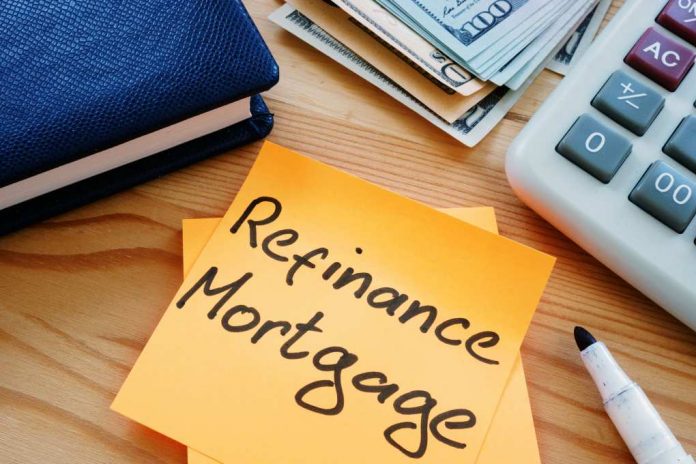
Many homeowners take advantage of a mortgage refinance because it can benefit them in a variety of ways from saving thousands on their mortgage, to getting cash out of their home, and more. However, homeowners that have a less than ideal credit score may find themselves wondering how they can still reap the benefits of a mortgage refinance. Luckily, those with a bad credit standing aren’t necessarily out of luck when it comes to refinancing their mortgage!
Understanding Your Mortgage
Before we dive into ways that those with a low credit score can refinance their mortgage, we must first make sure your understanding of a mortgage is accurate. Mortgages can seem simple but may not be as clear as you think. Simply put, a mortgage is a type of loan that is used to purchase or refinance a property (in this case your home). Your monthly mortgage payment is split up between four different factors:
- Principal Balance
- Overall Interest
- Insurance and Taxes
Principal Balance
The amount of money that remains on the loan is the loan principal. For example, if you borrow $225,000 but pay $75,000 then your principal is $150,000. A portion of your monthly mortgage payment will go towards the principal balance.
Overall Interest
Interest rates act as a fee that the lender charges to the borrower for taking out the loan. The overall interest you pay is based on the loan principal and the interest rate of the loan.This is also a big portion of your monthly mortgage payment. Luckily, as time goes on more of the monthly payment will go towards the principal balance instead of the interest.
Insurance and Taxes
This may not be applicable to every loan but it is still something to be aware of. If your loan has an escrow account, then your monthly payment could include payments for both homeowner insurance and property taxes.
What is a Mortgage Refinance
Now that you have a better understanding of your mortgage, how does the refinance process come into play? Well mortgage refinances are a popular option for homeowners that want to achieve some type of goal. There are a variety of refinance types but four popular options are:
- Rate-and-Term Refinance
- Cash-Out Refinance
- Cash-In Refinance
- FHA Streamline Refinance
Rate-and-Term Refinance
When homeowners think of a standard refinance this is what generally comes to mind. With a rate-and-term refinance, homeowners can get an updated interest rate and updated loan terms. Sometimes referred to as a “no-cash-out refinance”, this refinance will have the same principal loan balance of the existing loan.
Cash-Out Refinance
Homeowners that want to tap into their available equity can turn to a cash-out refinance. With this type of refinance, the new loan will be worth more than the remaining loan balance. This gives homeowners the chance to get cash out of their home when they want!
Cash-In Refinance
Sometimes homeowners want to improve their loan-to-value (LTV) ratio. This can be done with a cash-in refinance which acts like the opposite to a cash-out refinance. Instead of drawing funds out of the home, the homeowner will provide additional funds to reduce the overall amount that they owe to the lender.
FHA Streamline Refinance
An FHA streamline refinance is a great option for those whose mortgage is FHA-insured. This type of refinance has more flexible eligibility criteria and requires less verifications than other refinance options.
Who Do You Talk to About Refinancing Your Mortgage?
The best place to get started for the refinance process is to get in touch with a mortgage loan officer at a local branch of your current lender. If there are no local branches and your lender operates fully online then you will want to get in touch with them there. Sometimes, lenders may offer exclusive opportunities to existing customers. If you want to change lenders then you will need to do some comparison shopping before you make a decision.
Factors That Lenders Consider
The refinance process is pretty extensive. That is why you should have a rough idea of some of the factors that lenders look at when approving or denying applicants. Some factors that they look at are:
- The Amount of Down Payment
- Credit Standing
- Employment History
- Debt-to-Income Ratio (DTI)
The Amount of Down Payment
The amount of down payment that you provide is important. While a good rule of thumb is to have 20% of the home’s value for your down payment that doesn’t necessarily need to be the case. Lenders have options available for those that cannot provide such a hefty down payment so make sure to talk to them to see if any guidelines are in place.
Credit Standing
Your credit plays a big part in determining whether or not you will be approved for a mortgage refinance. Oftentimes lenders will have minimum credit score requirements. For example, generally conventional refinances require a minimum credit score of 620. This can be bad news for those that have a less than ideal credit score.
Employment History
It is common practice for lenders to review employment history of applicants. This information can help lenders get a better idea about the amount of risk involved with a borrower. For example, if you have no consistent work history and have a history of struggling to make ends meet then this can be a red flag for banks in your ability to repay your loan. Strong employment history means a strong showing of consistent income to handle the mortgage.
Debt-to-Income Ratio (DTI)
Your DTI is another important factor that lenders look at. This ratio shows the amount of debt payments you have compared to the amount of money you make every month. A good rule of thumb is to keep your DTI lower than 43% so that you don’t give the lender the idea that you are taking on more debt than you can handle. Lenders want to ensure their borrowers are not trying to overextend themselves financially.
Should You Refinance with Bad Credit?
Bad credit can feel like a weight on your chest that you can’t get off. Refinancing is an extensive process that is impacted by a bunch of factors. Even if you still qualify for a refinance, you will not get the best refinance setup possible. A good rule of thumb is the better the credit score then the better the rate and terms of the refinance.
When you choose to refinance with a less than ideal financial situation you may literally be paying for it in the long run. For example, with a credit score of 630 you may get an interest rate of 3.02%. If you instead had a score of 700 your interest rate could have been 2.54%. Now while that doesn’t seem like too much of a difference, it adds up over the course of the loan!
Need Help Refinancing Your Mortgage with Bad Credit?
Let’s say your credit score is 550, what can you do when it comes to refinancing your mortgage with bad credit? Luckily there are more opportunities than you may realize:
- Talk to Your Current Lender
- Check Out FHA Options
- Consider a VA-Streamline Refinance
- Check Out USDA Streamlined Assist Program
- Look Into Portfolio Refinance Loans
- Get a Co-Signer
- Improve Your Financial Situation
Talk to Your Current Lender (Be Honest About Your Credit Score)
The first and best place to start is with your current lender. Using the relationship you have built with your bank may be able to work to your benefit. If credit is the only issue you have but you have a strong source of income, a good DTI, a good LTV, etc., then you may be able to have an edge with the personal relationship you have at the bank.
Check Out FHA Options
The Federal Housing Administration (FHA) is a great tool for subprime borrowers to consider when trying to get a mortgage refinance. If you have a bad credit score and currently have an FHA loan then a streamline refinance may be just the right fit for you. In fact, even if your current loan is not FHA-insured, there still may be an opportunity available for your situation.
Consider a VA Streamline Refinance
If you are eligible for veteran assistance then a great option for those with a low credit score is a VA streamline refinance. This type of refinance is known as an Interest Rate Reduction Refinance Loan (IRRRL) and can help qualifying individuals in need.
Check Out USDA Streamlined Assist Program
The United States Department of Agriculture (USDA) created a program that can help those that want to refinance with bad credit because there is no credit check involved. As long as you currently have a mortgage through the USDA or have a mortgage backed by the USDA and have made mortgage payments on time, you may be able qualify.
Portfolio Refinance Loans
If you have a bad credit score then a portfolio loan may be able to help. These loans are obtained through mortgage brokers and banks who set their own eligibility criteria guidelines for the loan. This means that they tend to be more flexible than a conventional refinance. Every lender has a unique option available so you may benefit from comparison shopping to find something that works for your situation.
Get a Co-Signer
Sometimes your credit score could have such an impact on your approval rate that it may make sense to get the help from a co-signer. A co-signer that has a strong credit standing and income level is a great candidate. Co-signers guarantee to take on the responsibility if the primary borrower is unable to keep up with payments. Keep in mind that regardless of personal relationships, you want to make sure this transaction is handled like a business deal, even if your parent is your co-signer. This ensures that everyone involved will not feel like they got the short end of the stick especially if something goes wrong.
Improve Your Financial Situation
Sometimes you may not be able to get any refinancing options if your finances are in shambles. That is why you may need to turn to improving your financial situation before you try to get a refinance. Improving your credit score can be the key you need to unlock more financial opportunities. Some ways to improve your credit score include:
- Getting Your Utilization Rate Below 30%
- Paying All Bills On Time
- No More Hard Inquiries
While improving your credit score is a great way to improve your finances there are other ways that you can better yourself too! Some popular ways that people work on their finances include:
- Creating a Budget
- Saving Money
- Increasing Income
Can You Refinance Your Home Without Paying Anything?
Refinances are not cheap. A homeowner can expect to spend an average of $4,345 in just closing costs. This is a lot of money and can be difficult for homeowners to pay if they are dealing with financial hardship. When reviewing refinancing opportunities, you may come across a specific kind of refinance known as a “no-closing-cost” refinance. This refinance may sound like a great opportunity but can be a little misleading. While there are still closing costs, they won’t be due during closing. Every lender is different, oftentimes instead of paying the closing costs during closing they will be rolled into the overall loan amount. This means that there are still closing costs, which is what makes the name a little misleading.
Overall
Refinancing a mortgage with bad credit is difficult, but not impossible. It is important to understand your refinance options like a:
- Rate-and-Term Refinance
- Cash-Out Refinance
- Cash-In Refinance
- FHA Streamline Refinance
These options and more are what you need to consider before making a decision. Lenders look at a bunch of factors besides credit history like your down payment, your employment history, your DTI, etc. These factors play an important role in whether or not you will be approved for a refinance. Just because you submit an application doesn’t mean that you will get approved! If you are struggling with your credit score and finding refinance options then you may want to consider:
- Talking to Your Current Lender
- Checking Out FHA Options
- Considering a VA-Streamline Refinance
- Checking Out USDA Streamlined Assist Program
- Looking into Portfolio Refinance Loans
- Getting a Co-Signer
- Improving Your Financial Situation (i.e. improve your credit!)
Don’t give up hope and make sure to talk to your current lender. Even though your credit score is bad, there may be opportunities that you could qualify for. Sometimes your credit score is too bad so you may need to hold off on refinancing your property. If your motivation to refinance is so you can get a more manageable monthly payment, then talk to your lender. They may be more flexible than you realize if you are cost-burdened and need help.
















